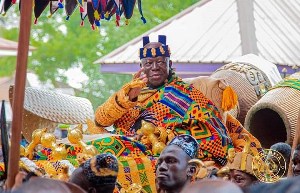- Home - News
- TWI News | TV
- Polls
- Year In Review
- News Archive
- Crime & Punishment
- Politics
- Regional
- Editorial
- Health
- Ghanaians Abroad
- Tabloid
- Africa
- Religion
- Election 2020
- Coronavirus
- News Videos | TV
- Photo Archives
- News Headlines
- Press Release
Opinions of Sunday, 18 September 2016
Columnist: Kwarteng, Francis
Highlife Legend Samuel Owusu’s Social Philosophy Of Music 9
“The notion that the distinctive quality of African music lies in its rhythmic structure, and consequently that the terms ‘African music’ and ‘African rhythm’ are often interchangeable, has been so persistently thematized in writings about African music that it has by now assumed the status of a commonplace, a topos. And so it is with the related ideas that African rhythms are complex, that Africans are essentially rhythmic people, and that Africans are different from ‘us’—from Euro-Americans” (Kofi Agawu, “The Invention of ‘African Rhythm,’” Journal of the American Musicological Society, 48 (3), p. 380-395).
HIGHLIFE (AND PALM-WINE MUSIC) CLASHES WITH HIPLIFE
On the other hand, as some may already paroemiology is also central to the cultural and philosophical richness of traditional highlife and palm-wine music and therefore members of the hiplife generation may want to dedicate some time to studying it.
We are rather referring to how these select few can adapt these formal rhetorical techniques to hiplife. Of course, it is easier said than done.
What is also rather true is the idea that hiplife is a largely urban-street phenomenon, a phenomenon far removed from the epicenter of linguistic sophistication typical of the cultural, philosophical and spiritual wisdom and of the rich world of aesthetic animism of the countryside.
By “animism” we are not referring to the Eurocentric concept of Traditional African Religion, say.
Traditional African Religion is largely about humanism as well as about man’s respect for and living in harmony with nature, not about any unrealistic Eurocentric construction of a concept far removed from African realities.
Thus, by “aesthetic animism” we are directly referring to practical traditional wisdom and intelligence based on humanism, respect for nature and community, respectful (“honorific”) speech, and cultural dignity associated with humble language and word beautification.
In other words, the hiplife generation is far removed from a generational paradigm of technical sophistication borne out of a rhetoric of cultural fluency, of mature linguistic proverbialism.
The fact that we mention humble language and respectful speech does not mean lyrical references to rich, mature experiential folksy innuendoes and wisecracks in music is a no-go area. Innuendoes and wisecracks and indirect discourse and many other subtle, or symbolic, rhetorical platforms, after all, enrich human communication—language.
The notion of cognitive investment in decoding the subtle language of a piece of music makes for an interesting case in exercising the human intellect and, more particularly, in these days when the human intellect is in an apparent decline.
The hiplife generation on the other hand feeds on the creative paradigm of spoken word, that is, word play, but mostly without solid foundational ingredients of cultural wisdom, humanism, respect for nature and the like, what we have already referred to as “aesthetic animism” for short.
A SPECIAL GIFT TO OUR DEDICATED READERS, RECORD PRODUCERS, SONGWRITERS, AND MUSICIANS
“Finally, Kwabena Nketia, the most prominent African scholar of African music, justifies the apparent poverty of other dimensional behaviors in African music by appealing to the predominance of percussive textures: ‘since African music is predisposed towards percussion and percussive textures, there is an understandable emphasis on rhythm, for rhythmic interest often compensates for the absence of melody or the lack of melodic sophistication…’
“African rhythm, in short, is always already complex…The notion of an irreducibly complex African rhythm has been promulgated by both Western and African scholars” (see Kofi Agawu’s book “Representing African Music: Postcolonial Notes, Queries, Positions”).
Here Prof. Kofi Agawu’s above-referenced epigrammatic observation appears to capture the essential character of Nketia’s remarks. We shall go no further than this.
We will therefore, instead, implore those readers who are interested in these questions to consult all the sources we have provided thus far for in-depth analyses of the issues these scholars have raised about African music in general and African rhythm in particular.
That said, we will also do well to encourage our dedicated readers to make time and listen to the following songs by the Ramblers Dance Band:
“Gyae Su Nu Nkomo,” “Egyanka Dabre” (Nana Kwame Ampadu has a version of this song too), “Meni Nda Obiara So,” “Ama Bonsu,” “Onuapa Due,” “Ewuraba Artificial”…
CONCLUDING REMARKS
That is to say, cultural illiteracy in addition to linguistic and spiritual vulgarity (emptiness), lack of moral consciousness and social-political maturity are the norm in the hiplife generation.
Here (2002) is the Executive Director of the Ghanaian ranch of the International Federation of the Women Lawyers (FIDA) on hiplife (Drewett & Cloonan):
“…some hip hop lyrics ‘debase femininity and the bodies of women… (and) constitutes violence against women on the airwaves.’”
Drewett and Cloonan continue:
“FIDA threatened high court actions against some radio stations and disc jockeys. Both FIDA and the Musicians Union of Ghana (MUSIGA) have also asked the Ministry of Information and the Ghana Media Commission to closely monitor the local FM stations for decent lyrics.”
Here is the irony according to the authors:
“But as the journalist William Asiedu (“Mirror,” 28 December 2002) commented, hiplife songs that are banned or ‘come under fire for spawning immorality amongst the youth…make good sales throughout the country…and become instant hits and chart busters’…
“…A more continuous and cyclical form of hegemonic control over youth popular (and neo-traditional music) has emanated over the years from both the traditional authorities and the older and more conventional layers of the general public in any period.
“These include the suppression of young highlife musicians by some traditional rulers in the early twentieth century, the traditional elders disdain for youthful simpa, konkomba and kpanlogo in the 1930s, 1940s and 1960s, the moral indignation of the older generation of urban Ghanaians over some of the highlife records of E.K. Nyame and King Bruce in the 1950s and 1960s, right up to the current dislike of hiplife and its associated youth sub-culture by parents of today…”
But good music is simply good music and not much can be done about it. As simple as that! Read on:
“This is it. The best request of the batch! C.K. Mann paid his dues and polished his skills in the legendary Kakaiku Guitar Band of Ghana in the 1960s. The history and cross-cultural trackings of African Highlife and Afrobeat are too detailed to chronicle here, but the influence of black American music in Ghana is undeniable (see details on the Soul to Soul concert of 1971).
“C.K. Mann eventually split from Kakaiku to form his own outfit, which was a big deal in early-'70s Ghana. As the likes of Fela Kuti made the sounds of Afrobeat hard to ignore, hip hop producers and DJs began to dig deeper. It was when Double Dee and Steinski sampled a track from Funky Highlife (1974) that a resurgence in interest forced its re-release on CD.
“Thank God for Hip Hop and those sample-hungry DJs! Keep digging! The LP is now a collector's item; but never fear, we've got the CD. This recording is the perfect example of American funk and soul influences sifted through traditional African musical sensibilities.”
The song this popular American duo sampled was the track “Asafo Beesuon.” Read this:
“Then Steinski, one of the most influential producers in hip hop, sampled Asafo Beesoun and suddenly all the hip hop collectors wanted it. The original LP is a hard-to-find and sought-after collector’s item.”
Yet the genre entertains nonetheless, although we still have to learn to do the right thing as a people, a topical issue Alex Konadu covered on his track “Yensua Yo”!
Finally, read this also about Ghana’s forgotten great highlife Eddie Quansah:
“Eddie’s story however, is much bigger than King Cobra…
“Before moving to Australia he played on hit records by The Stargazers, Johnny Nash, Cat Stevens, Suzie Quatro, Toots and the Maytals, Bryan Ferry, The Reels and Bob Marley. Since the demise of King Cobra, he’s been teaching schoolchildren about the sounds and rhythms of African music.
“Eddie grew up in Kumasi, Ghana, in a musical neighbourhood that included future Osibisa founder Teddy Osei…
“Emerging a more confident musician he found work around London playing in clubs before joining Johnny Johnson and the Bandwagon for a tour of the UK. Then Eddie heard that Johnny Nash, an artist he had long admired, was looking to put together a band. He auditioned and got the gig…
“The band that Nash put together comprised four Ghanaians and four Texans, and the first thing they recorded together was the worldwide hit ‘I Can See Clearly Now.’ At the time, Nash’s manager was also grooming Bob Marley for the UK market and Eddie would often play soccer with him in the park. The pair developed a friendship that led to Eddie playing trumpet on his hit ‘Reggae On Broadway.’
“In 1974, Eddie was approached to work on an adaptation of Gilbert and Sullivan’s musical The Mikado. The Cambridge Theatre Company’s production of The Black Mikado opened a year later, and Eddie was leader of the house group who became known as the Titipu Band. The plot remained fairly true to the original musical, but the music was very different combining elements of Caribbean, jazz and funk grooves…”
Jimmy Cliff’s rendition (cover version) of Johny Nash’s “I Can See Clearly Now” is probably more popular.
In fine, it is important that surviving members of the old generation impart their musical knowledge to the younger generation. This is what Koo Nimo has been doing.
What is more, our “celebrities” in the music industry, particularly, should learn from a great man as Koo Nimo, a lecturer, scientist (chemist), laboratory technician, musician and PhD-holder who is still tied to all the good things we can associate with our traditional culture.
His musical journey is as interesting as his music, a sterling musical-career biography which members of the hiplife generation should know more about (See Andrew L. Kaye’s 1999 paper “Koo Nimo: A Contemporary Ghanaian Musician,” Journal of the International Library of African Music, Vol 7 (4), p. 147-165).
Let also celebrate Ephraim Amu, J.H. Kwabena Nketia, Philip Gbeho, E.T. Mensah, Nana Ampadu…as well as influential music scholars such as Prof. Victor Kofi Agawu (from the Volta Region) of Princeton University.
A well-known Schenkerian analyst, a topical theorist, and a Royal College of Music- and Royal Academy of Music-certified music educator, Prof. Agawu is an expert on ethnomusicology and music semiology.
His book “African Rhythm: A Northern Ewe Perspective,” which deconstructs many misconceptions about African rhythm, is a must-read!
These are the kind of people members of the hiplife generation should have as mentors.
REMINDER
This concludes the series.
REFERENCES
Michael Drewett & Martin Cloonan. (March 23, 2016). “Popular Music Censorship in Africa.” Routledge.
Mr. Bongo. “The story of C.K Mann & His Carousel 7 ‘Funky Highlife.’” December 5, 2012. Retrieved from http://www.mrbongo.com/blogs/news/7002852-the-story-of-c-k-mann-his-carousel-7-funky-highlife
Andy Wagstaff. “Best of Patron Requests: Music (September 2013 edition).” Retrieved from https://www.nypl.org/blog/2013/09/26/best-patron-requests-music-september-2013
“Eddie Quansah: Body Music, Happiness, Rhythms And Joy.” November 2, 2014. Retrieved from http://www.abc.net.au/radionational/programs/rarecollections/eddie-quansah3a-body-music2c-happiness2c-rhythms-and-joy/5850884
Moshood Balogun. “Music People Sample M.anifest’ ‘Nowhere Cool.’” September 6, 2016. Retrieved from http://yoyotinz.com/write-ups/music-people-sample-m-anifests-nowhere-cool/










